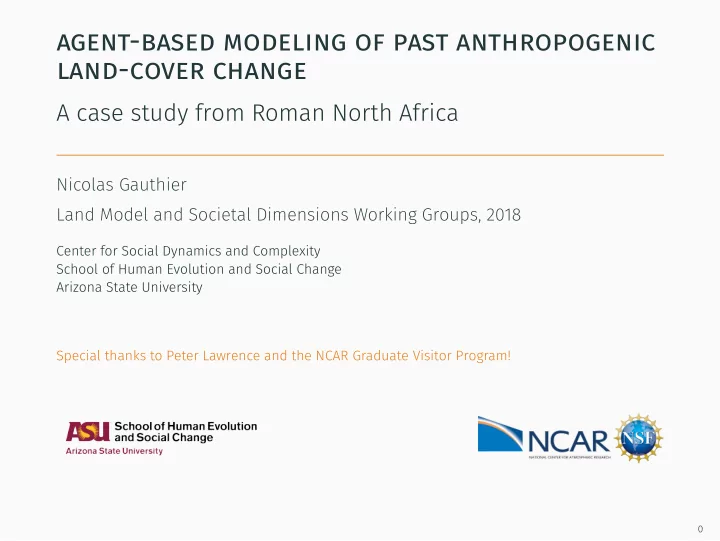

agent-based modeling of past anthropogenic land-cover change A case study from Roman North Africa Nicolas Gauthier Land Model and Societal Dimensions Working Groups, 2018 Center for Social Dynamics and Complexity School of Human Evolution and Social Change Arizona State University Special thanks to Peter Lawrence and the NCAR Graduate Visitor Program! 0
background
roman north africa The province of Africa Proconsularis – roughly modern day Algeria, Tunisia, and Libya – was the breadbasket of the Roman Empire 2
roman north africa Was the region’s productivity the result of climate or irrigation? 3
closing the loop Land cover prescribed from population-based hindcasts lack feedbacks between humans and climate 4
anthropogenic land-cover change North Africa is a region of tight land-atmosphere coupling, and experienced massive land-cover change during Roman Imperial period 5
closing the loop Need for dynamical feedbacks between human and Earth systems in the past, but we lack the data needed for a fully parameterized IAM 6
multi-agent simulation
agent-based modeling Complexity arises when simple agents with heterogeneous information, objectives, and resources interact 8
adding social complexity Need more flexible representations of the complex social dynamics that drive land-use and land-cover change 9
∙ weather ∙ maximum potential crop yields ∙ vegetation initial conditions at equilibrium with climate ∙ agriculture and pasture land ∙ wood harvest intensity ∙ population density ∙ land equipped for irrigation 1. Use ESM outputs as model inputs 2. Output maps of that can be read into a Land Surface model integration with clm Linkages to CLM/CESM 10
∙ agriculture and pasture land ∙ wood harvest intensity ∙ population density ∙ land equipped for irrigation 2. Output maps of that can be read into a Land Surface model integration with clm Linkages to CLM/CESM 1. Use ESM outputs as model inputs ∙ weather ∙ maximum potential crop yields ∙ vegetation initial conditions at equilibrium with climate 10
integration with clm Linkages to CLM/CESM 1. Use ESM outputs as model inputs ∙ weather ∙ maximum potential crop yields ∙ vegetation initial conditions at equilibrium with climate 2. Output maps of that can be read into a Land Surface model ∙ agriculture and pasture land ∙ wood harvest intensity ∙ population density ∙ land equipped for irrigation 10
modeling roman land use
2. Use a multilevel modeling framework to capture both individual-level demography and large-scale migration flows core design principles 1. Allocate land use via decision making of boundedly rational households, rather than deterministic functions of population density or land suitability 12
agent-level decision making Households allocate labor to: 1. Make food by farming (wheat and olive) or herding (sheep and goat) 2. Invest in infrastructure by repairing irrigation canals or maintaining social ties 13
agent-level heterogeneity Agents differ in their objectives: ∙ Maximizers - maximize food, subject to labor constraints ∙ Satisficers - minimize labor, subject to food constraints 14
spatial land use impacts Spatial distribution of land use is mediated by topography 15
2. Use a multilevel modeling framework to capture both individual-level demography and large-scale migration flows core design principles 1. Allocate land use via decision making of boundedly rational households, rather than deterministic functions of population density or land suitability 16
core design principles 1. Allocate land use via decision making of boundedly rational households, rather than deterministic functions of population density or land suitability 2. Use a multilevel modeling framework to capture both individual-level demography and large-scale migration flows 17
multi-level modeling 18
demography Individual level demography constrained by food production 19
multi-level modeling 20
multi-level modeling 21
migration and spatial interaction Flows of people and resources are routed on a network of cities and roads via an entropy maximizing spatial interaction model 22
summary
∙ Agent based models provide a flexible alternative to IAMs where input data are lacking ∙ Land surface modelers can draw on anthropology and archaeology to better understand past land-use dynamics on multiple scales summary ∙ Static land use maps are insufficient to simulate Holocene paleoclimate scenarios such as Roman North Africa 24
∙ Land surface modelers can draw on anthropology and archaeology to better understand past land-use dynamics on multiple scales summary ∙ Static land use maps are insufficient to simulate Holocene paleoclimate scenarios such as Roman North Africa ∙ Agent based models provide a flexible alternative to IAMs where input data are lacking 24
summary ∙ Static land use maps are insufficient to simulate Holocene paleoclimate scenarios such as Roman North Africa ∙ Agent based models provide a flexible alternative to IAMs where input data are lacking ∙ Land surface modelers can draw on anthropology and archaeology to better understand past land-use dynamics on multiple scales 24
closing the loop ESMs provide physically consistent representations of land-atmosphere feedbacks using scientifically validated models with well-engineered software components ABMs allow for bottom-up generation of land-use maps that continuously contribute to and adapt to environmental variability 25
Recommend
More recommend